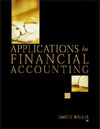|
 |  Applications for Financial Accounting David Willis
Preface
Applications for Financial Accounting is written for the new accounting training package that covers the following units of competence:
FNBACC01A
FNBACC02A
FNBACC03A
FNBACC04A
FNBACC05A
FNBACC06A
|
Provide financial information
Prepare statutory returns
Prepare budgets and forecasts
Produce financial reports
Establish and maintain financial systems and records
Implement financial policy statements and operating procedures
|
In this text, some states will find that we have covered topics that are not required immediately. For example, Chapter 9, Statement of cash flows, which is part of the New South Wales syllabus, may be useful preparation during your study of company accounting subjects. Chapter 9 focuses on single-owner businesses and other non-companies. It is not difficult to extend the contents of this chapter to include company accounting terminology. Similarly, Chapter 8, Accounting for leases, prepares you for studying this topic in a relevant subject or module attended at a later time.
Tools to help you:
- This text is packaged with a free workbook that is designed to save you time. There is no need to waste time drawing tables during class and when you're completing homework assignments. Look for the text-at-a-glance on page xii to learn how the text and workbook interact with each other.
- A website accompanies Applications for Financial Accounting. The address can be found on the inside front cover of this text. The website hosts PowerPoint slides and more questions to help you review your study. You can also find hot links to key financial accounting topics.
- The book is filled with its own activities, tutorials and homework questions. The text-at-a-glance indicates how you can use these items to your best advantage.
Financial report name changes
The names of two major financial reports have been changed as required by Australian accounting standards. The Profit and Loss Statement and the Balance Sheet have been replaced with the Statement of Financial Performance and the Statement of Financial Position respectively.
The names of the two major reports-Statement of Financial Performance and Statement of Financial Position are similar to each other. Here is a guide to differentiate between them:
- Statement of Financial Performance
- The performance is as a result of transactions over time. This report is for the month ending, half-year ending or year ending, say, 30 June 2009.
- This statement contains revenue, expenses, and profits and losses.
- Statement of Financial Position
- This demonstrates the position of the business at any point in time. So it is 'as at' a particular date-for example, as at 30 June 2009.
- This statement contains assets, liabilities and equity.
Statement of Financial Performance-Australian Accounting Standard AASB 1018
The standard states that this standard should be applied to each entity that is: required to prepare financial reports in accordance with Chapter 2M of the Corporations Law; mainly considered to be a company; and is to operate on, and from, the first financial period after 30 June 2001.
Strictly speaking, the chapters and references in this book are for non-reporting entities, so the standard may not fully apply, but accounting standards are expected to be applied, in principle, to businesses whether they are reporting or non-reporting entities. The new terminology has been used throughout the book, in preparation for it to be utilised in company accounting modules.
Where applicable, Profit and Loss Ledger Accounts can still be maintained with that name as they are internal sources of information. In Chapter 3, the statements to ascertain profit are unaffected by this change. In Chapter 6, the Profit and Loss Appropriation Account is retained. For internal accounting, account names can be called whatever the business chooses; it is only the name of the statement that, for external purposes, has changed.
The essential feature of the Statement of Financial Performance, at this level of learning, is that it must show the cost of goods sold. Also the terms for ordinary and extraordinary items are defined to the extent that the latter items will now be a rare occurrence. It is considered that the changes will mean that more meaningful and consistent information is supplied to users of the financial statements of a business.
Statement of Financial Position-Australian Accounting Standard AASB 1040
The Statement of Financial Position applies to financial reporting for periods after 30 June 2001 for reporting entities, normally referred to as companies. The business name and 'as at' a particular point in time still apply to the title at the head of the statement.
The essential feature of the Statement of Financial Position, at this level of learning, is that current and non-current assets and liabilities must be shown separately from each other in the statement. Statements of Financial Position, in this book, will require some varied presentations. Some questions will require the working capital to be calculated. This is simply the total of current assets less current liabilities and it provides useful information about a business's ability to meet its short-term commitments. Non-current items will be shown after the working capital figure.
Acknowledgments:
I would like to thank all of the teachers and trainers who helped to develop Applications for Financial Accounting. I would also like to thank the team from McGraw-Hill who worked on this text - Michael Tully and Kim Ross. The editor for this project was Felicity Shae; thank you for doing such a terrific job.
David Willis.
|
|
|



 2002 McGraw-Hill Higher Education
2002 McGraw-Hill Higher Education

 2002 McGraw-Hill Higher Education
2002 McGraw-Hill Higher Education